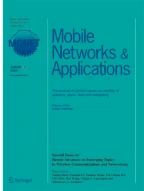Abstract
Few years ago some network operators launched a new service called Community Networks, where each subscriber shares its residential Internet connection with other subscribers of the same operator via his 802.11 access point. Due to the high access point density in urban areas, community networks have the potential to offer high data rate wireless Internet access for mobile users, going beyond the currently available hot-spots, which are typically deployed in a limited number of isolated locations (e.g., airports, cafes). Unlike cellular networks, the locations of community network access points is not centrally planned. We evaluate existing community networks using a participatory sensing application called Wi2Me. First, we analyze different metrics in order to characterize community networks. Second, we take advantage of this unique 802.11 network (in terms of density and coverage) to study how mobility can be supported by identifying drawbacks and proposing some possible solutions.
Similar content being viewed by others
Notes
An online map with the estimated locations of the APs is available at: http://labo4g.enstb.fr/wi2me
The server is hosted in the same institution as the SALSA network.
References
Ai X, Srinivasan V, Tham C-K (2009) Wi-Sh: a simple, robust credit based wi-fi community network. In: INFOCOM. IEEE
Aguayo D, Bicket J, Biswas S, Judd G, Morris R (2004) Link-level measurements from an 802.11b mesh network. SIGCOMM Comput Commun Rev 34:121–132
Brik V, Rayanchu S, Saha S, Sen S, Shrivastava V, Banerjee S (2008) A measurement study of a commercial-grade urban WiFi mesh. In: ACM IMC ’08
Arjona A, Takala S (2007) The Google muni Wifi network–can it compete with cellular voice? In: Proc. of the the 3rd advanced int. conf. on telecomm
Bychkovsky V, Hull B, Miu A, Balakrishnan H, Madden S (2006) A measurement study of vehicular internet access using in situ wi-fi networks. In: MobiCom ’06. ACM, New York
Castignani G, Lampropulos A, Blanc A, Montavont N (2012) Wi2me: a mobile sensing platform for wireless heterogeneous networks. In: Proc. of the 2nd int. workshop on sensing, networking, and computing with smartphones (ICDCS 2012). IEEE
Subramanian AP, Gupta H, Das S R (2007) Minimum interference channel assignment in multi-radio wireless mesh networks. In: 4th Annual IEEE communications society conference on sensor, mesh and ad hoc communications and networks, 2007. SECON ’07, pp 481–490, 18–21 June 2007. doi:10.1109/SAHCN.2007.4292860
Giordano E, Frank R, Pau G, Gerla M (2010) CORNER: a realistic urban propagation model for VANET. In: WONS ’10
Bychkovsky V, Hull B, Miu A, Balakrishnan H, Madden S (2006) A measurement study of vehicular internet access using in situ wi-fi networks. In: MobiCom ’06
Perkins C (2002) IP mobility support for IPv4. RFC 3220, IETF
Goff T, Moronski J, Phatak D, Gupta V (2000) Freeze-tcp: a true end-to-end tcp enhancement mechanism for mobile environments. In: Proceedings of NFOCOM 2000, vol 3. IEEE, pp 1537–1545
Bahl P, Hajiaghayi M, Jain K, Mirrokni S, Qiu L, Saberi A (2007) Cell breathing in wireless lans: algorithms and evaluation. IEEE Trans Mob Comput 6:64–178
Song Q, Jamalipour A (2005) A network selection mechanism for next generation networks. In: 2005 IEEE international conference on communications, 2005. ICC 2005, vol 2. IEEE, pp 1418–1422
Stevens-Navarro E, Wong V (2006) Comparison between vertical handoff decision algorithms for heterogeneous wireless networks. In: Vehicular technology conference, 2006. VTC 2006-Spring, vol 2. IEEE 63rd, pp 947–951
Lee K, Rhee I, Lee J, Chong S, Yi Y (2010) Mobile data offloading: how much can WiFi deliver? In: Co-NEXT ’10
Castignani G, Loiseau L, Montavont N (2011) An evaluation of IEEE 802.11 community networks deployments. In: ICOIN, ’11
Author information
Authors and Affiliations
Corresponding author
Rights and permissions
About this article
Cite this article
Castignani, G., Blanc, A., Lampropulos, A. et al. Urban 802.11 Community Networks for Mobile Users: Current Deployments and Prospectives. Mobile Netw Appl 17, 796–807 (2012). https://doi.org/10.1007/s11036-012-0402-2
Published:
Issue Date:
DOI: https://doi.org/10.1007/s11036-012-0402-2
